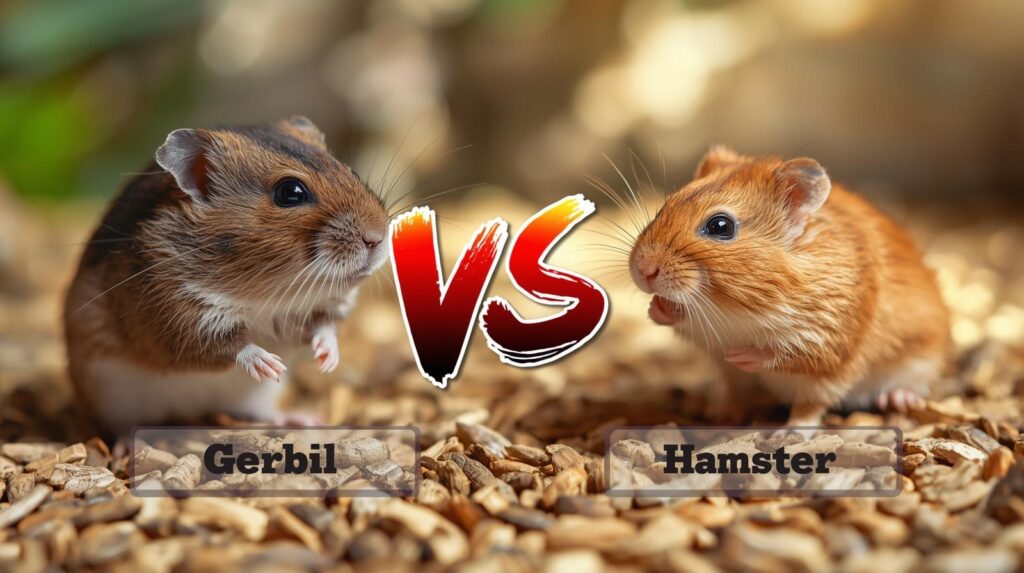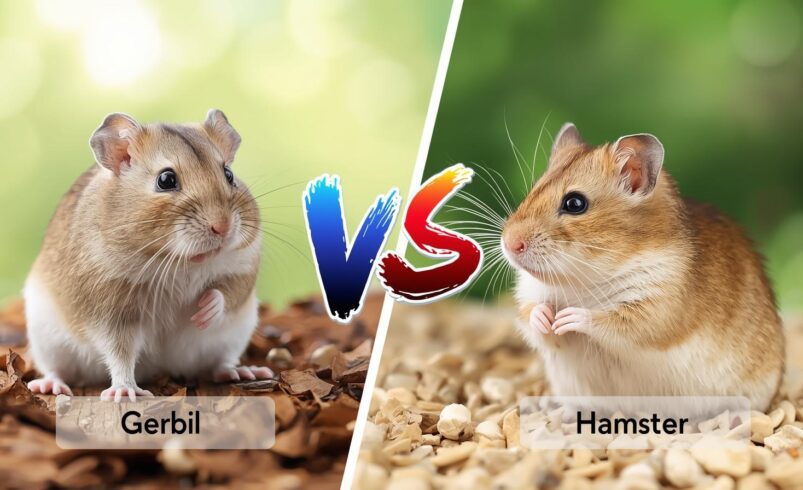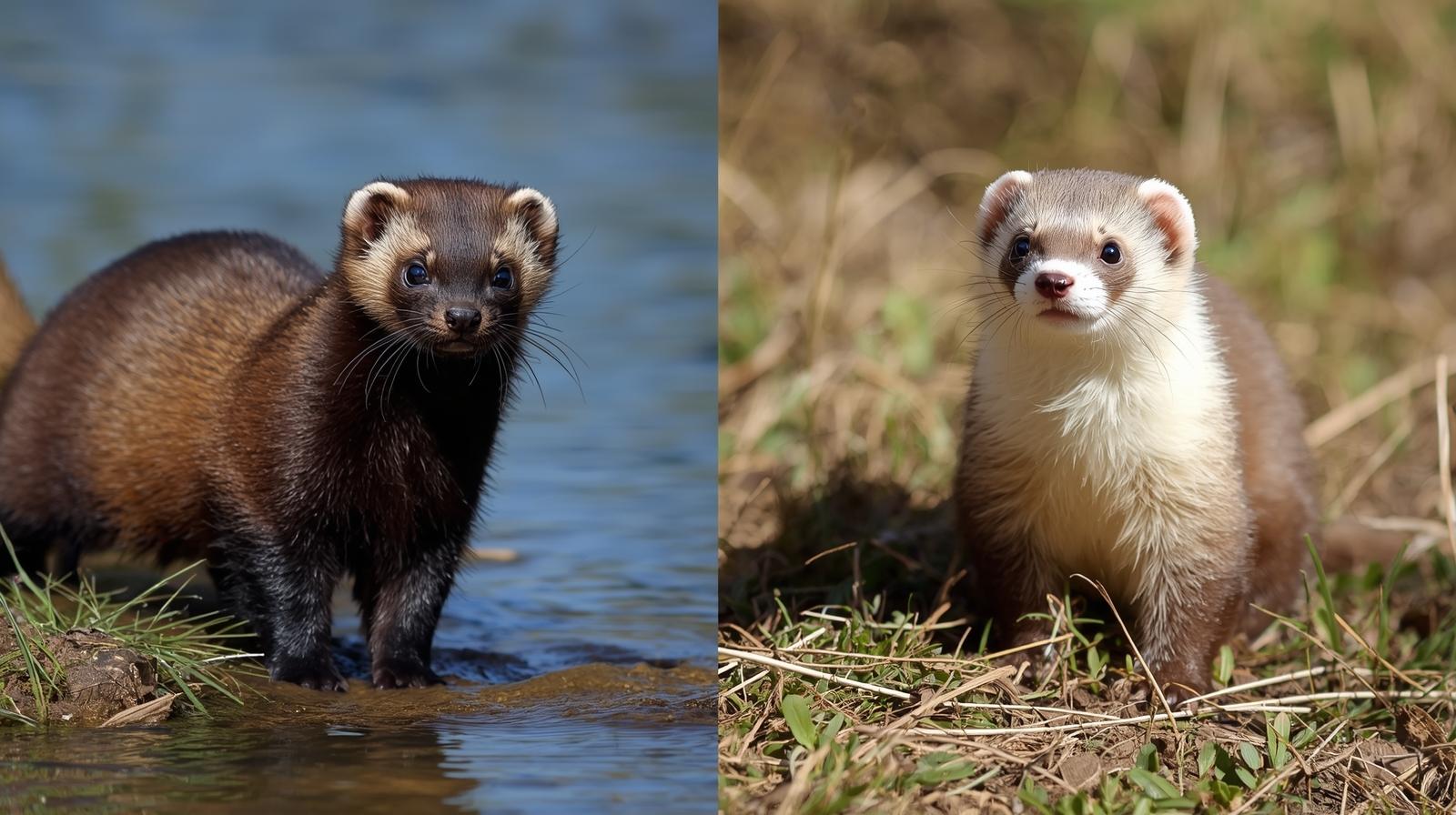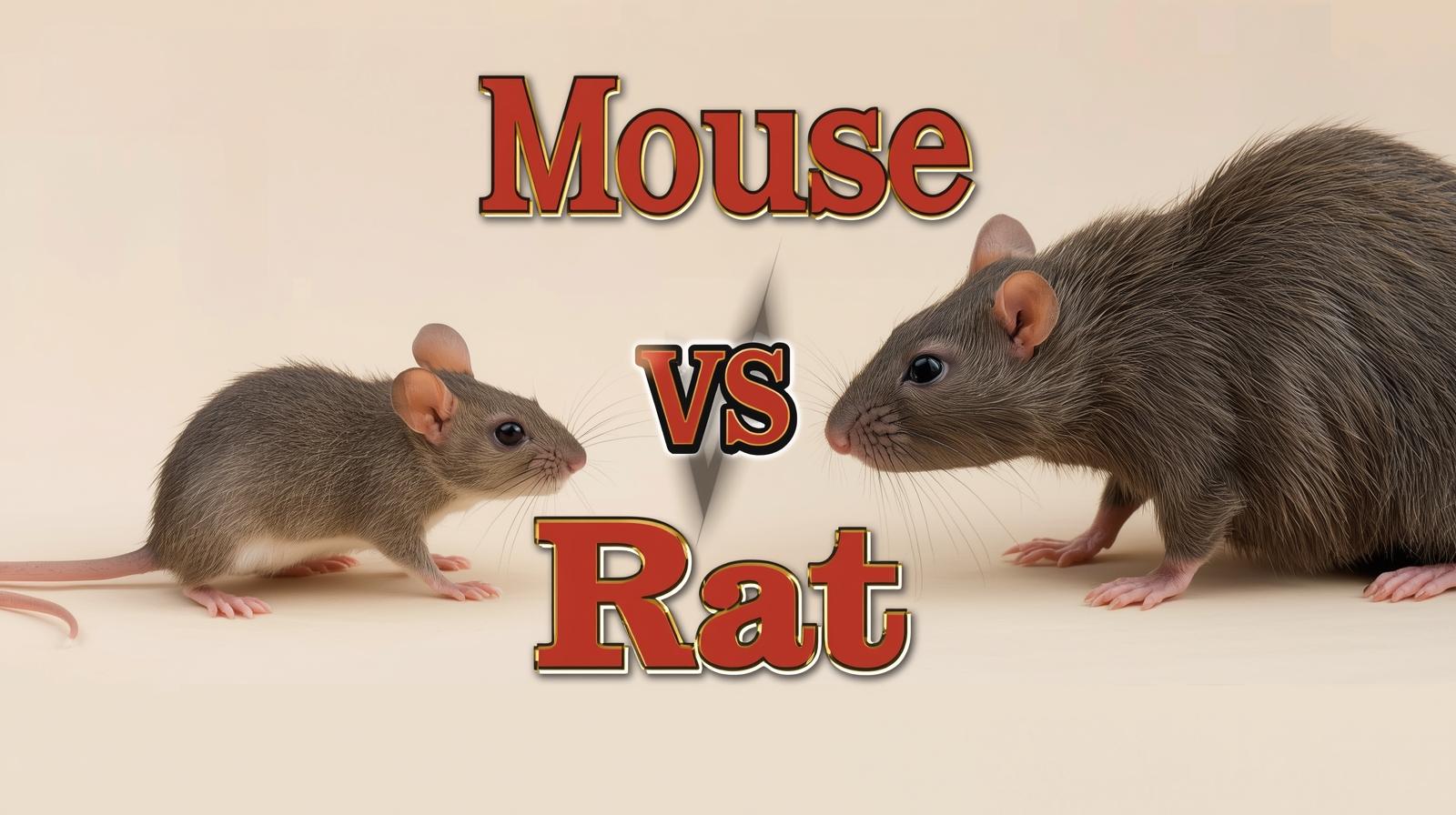

Choosing between a gerbil vs hamster isn’t just about picking the cutest face in the pet store window. I learned this the hard way when I brought home what I thought was a friendly hamster, only to discover it preferred midnight solo adventures to daytime cuddles. The decision between these two pocket-sized companions affects everything from your sleep schedule to your monthly pet budget, and understanding their fundamental differences can save you years of mismatched expectations.
While both creatures fall under the small rodent category, the gerbil vs hamster debate reveals surprisingly stark contrasts in social behavior, activity patterns, and care requirements. According to Statista, the hamster population in the UK was estimated at 600,000 in 2024, demonstrating their continued popularity despite the growing interest in alternative small pets like gerbils. This comprehensive guide breaks down everything you need to know about these furry friends, from their biological differences to the real costs of ownership.
Understanding the Gerbil and Hamster Fundamentals
Before diving into the gerbil vs hamster comparison, let’s establish what makes each species unique. Gerbils, scientifically known as Mongolian gerbils or Meriones unguiculatus, originate from the deserts of Mongolia and northern China. These social creatures have adapted to harsh, arid environments where cooperation meant survival. Hamsters, particularly the Syrian hamster (Mesocricetus auratus), hail from the semi-arid regions of Syria and Turkey, where solitary living helped them avoid competition for scarce resources.
The evolutionary backgrounds explain why gerbils thrive in pairs or groups while hamsters prefer their own company. When considering a gerbil or hamster for your household, this distinction becomes your first major decision point. Gerbils require companions of their own species, meaning you’re committing to at least two pets, double the cage space, and potentially dealing with breeding if you don’t choose same-sex pairs carefully.
Pet ownership statistics show that approximately 71% of U.S. households owned a pet in 2024, with small mammals representing a growing segment of this market. The gerbil vs hamster decision often comes down to whether you want to observe complex social interactions or focus on bonding with a single, independent pet.
Physical Differences Between Gerbil and Hamster
| Feature | Gerbil | Hamster |
| Body Length | 4-5 inches | 5-7 inches (Syrian) |
| Tail Length | 3-4 inches (long, furry) | 0.5-1 inch (short, stubby) |
| Weight | 2-3 ounces | 4-6 ounces |
| Lifespan | 3-4 years | 2-3 years |
| Active Period | Diurnal (daytime) | Nocturnal (nighttime) |
| Social Structure | Group-living | Solitary |
The physical distinctions in the gerbil vs hamster comparison extend beyond mere measurements. Gerbils sport elongated hind legs built for jumping and digging, giving them an athletic, kangaroo-like appearance when they stand upright. Their tails serve as balancing tools and fat storage reserves during lean times. Hamsters, conversely, have compact, rounder bodies with expandable cheek pouches that can hold food equivalent to half their body weight.
These anatomical differences directly impact their housing needs. A gerbil enclosure requires vertical space for climbing and deep bedding for elaborate tunnel systems I’ve watched my friend’s gerbils create underground networks that would impress civil engineers. Hamster habitats need horizontal space with multiple levels, hideouts, and enough room for their enormous exercise wheels.
Behavioral Patterns: The Social Dynamic
The behavioral aspect of the gerbil vs hamster debate represents perhaps the most critical consideration for prospective owners. Gerbils are remarkably social animals that communicate through various vocalizations, scent marking, and physical grooming. In my experience visiting breeders, I’ve observed gerbils sleeping in communal piles, sharing food without conflict, and even showing signs of distress when separated from their cage mates.
Hamsters tell a completely different story. Syrian hamsters, the most common pet variety, are fiercely territorial. Housing two Syrian hamsters together after maturity almost guarantees serious fighting, potentially fatal injuries. Dwarf hamster species like Campbell’s or Winter Whites show slightly more tolerance for same-sex pairs if raised together, but even these arrangements can deteriorate into aggression as they mature.
When evaluating gerbil or hamster temperament with children, gerbils generally prove more forgiving. Their daytime activity aligns with kids’ schedules, and their social nature makes them less prone to defensive biting. Hamsters, being nocturnal, often feel disturbed by daytime handling and may nip when startled from sleep. That said, a well-socialized hamster can become quite tame, especially if interaction happens during their natural evening activity peak.
Daily Care Requirements and Time Commitment
The practical aspects of the gerbil vs hamster comparison significantly affect your daily routine. Gerbils produce less odor than hamsters due to their desert adaptation they concentrate urine to conserve water, resulting in drier waste. This means gerbil cages typically need complete bedding changes every 2-3 weeks compared to weekly changes for hamsters. For more general pet care information across species, alldandy offers comprehensive resources.
However, gerbils compensate with higher activity levels. They require larger enclosures (minimum 20 gallons for a pair, though 40 gallons works better) with extensive enrichment. I’ve seen gerbil owners create elaborate setups with connected tanks, cardboard structures, and rotating toy collections to prevent boredom. Hamsters need substantial space too Syrian hamsters demand 450+ square inches of continuous floor space but they’re more content with static wheel-and-hideout configurations.
The gerbil vs hamster feeding routine shows minimal differences. Both species thrive on commercial pellet mixes supplemented with small amounts of fresh vegetables, occasional protein sources like mealworms, and unlimited water access. Gerbils eat approximately 1-2 tablespoons of food daily, while hamsters consume similar amounts but tend to hoard extensively in their burrows.
Cost Analysis: Initial Investment and Ongoing Expenses
The pet hamster products market was estimated at $500 million in 2025, projected to reach approximately $750 million by 2033, indicating robust commercial support for hamster ownership. The financial reality of the gerbil vs hamster decision extends beyond purchase price.
Initial setup costs for either species range from $150-$300, including an appropriate enclosure, water bottle, food bowls, bedding, hideouts, exercise wheel, and starter food supplies. Gerbils require purchasing at least two animals (typically $20-$40 each), effectively doubling the pet acquisition cost compared to a single hamster ($15-$30). However, gerbils need less frequent bedding replacement, potentially balancing monthly expenses.
Ongoing monthly costs average:
- Food and treats: $15-$25
- Bedding material: $10-$20 (hamsters use more)
- Toy rotation: $5-$10
- Veterinary savings fund: $10-$15
Exotic veterinary care represents a significant hidden cost in the gerbil vs hamster equation. Not all veterinarians treat small rodents, and those who do often charge premium rates. Emergency visits can easily exceed $200-$400, with diagnostic imaging or surgery pushing costs into four figures. The longer lifespan of gerbils means potentially higher lifetime veterinary expenses despite lower individual visit frequency.
Health Considerations and Common Issues
Understanding the health profile in the gerbil vs hamster comparison helps prepare for potential medical challenges. Gerbils prove relatively hardy but susceptible to respiratory infections, particularly when housed in dusty bedding. Their tails are delicate and can “deglove” if handled roughly a painful injury where the skin separates from the tail bone. Epileptic seizures occur in some gerbil lines, usually triggered by stress or sudden movements, though affected animals often live normal lifespans with proper management.
Hamsters face different health challenges. Syrian hamsters are prone to wet tail (proliferative ileitis), a serious bacterial infection causing severe diarrhea and requiring immediate veterinary attention. Dental problems emerge from inadequate chewing opportunities, as their teeth grow continuously throughout life. Older hamsters frequently develop tumors, particularly females with mammary gland tumors that can dramatically affect quality of life in their final months.
The preventative care in the gerbil vs hamster comparison remains similar: providing appropriate diet, maintaining clean housing, offering enrichment to reduce stress, and conducting weekly health checks. Early detection of issues like weight loss, labored breathing, eye discharge, or behavioral changes dramatically improves treatment outcomes.
Choosing Between Gerbil or Hamster for Your Lifestyle
After reviewing all factors, the gerbil vs hamster decision ultimately aligns with your specific circumstances. Choose gerbils if you want daytime entertainment, enjoy observing complex social behaviors, have space for larger setups, and don’t mind committing to multiple animals. Their longer lifespan provides extended companionship, and their lower odor suits apartment living better.
Select hamsters if you prefer evening interaction times, want a solitary pet focused on bonding with you, or have limited space for more compact housing. Syrian hamsters particularly suit individuals seeking a single pet with distinctive personality quirks, while dwarf varieties offer slightly more flexibility in pair housing.
For families with young children, the gerbil vs hamster choice often favors gerbils due to their diurnal nature and more tolerant temperament. However, older children with established routines and patience for evening interaction can develop rewarding relationships with hamsters. According to Petmd, both species require supervision during handling regardless of the child’s age.
Consider your noise sensitivity carefully. While neither species vocalize excessively, hamsters running on wheels at 2 AM can disrupt light sleepers. Gerbils do their tunnel excavation and cage rearrangement during daytime hours, potentially interfering with remote work calls or afternoon naps.
Making the Final Decision
The gerbil vs hamster debate doesn’t have a universal correct answer both species offer unique rewards and challenges. I’ve watched gerbil owners delight in their pets’ acrobatic displays and social grooming rituals, while hamster enthusiasts proudly share videos of their solitary companions stuffing impossibly large amounts of food into those expandable cheeks.
Your success with either gerbil or hamster depends less on which species you choose and more on researching their specific needs, preparing appropriate housing before bringing them home, and committing to daily interaction and care. Both creatures deserve owners who understand their natural behaviors rather than expecting them to conform to preconceived notions of what a “good pet” should be.
The growing pet industry, particularly the small mammal segment, continues developing better products, educational resources, and veterinary support. This means whether you choose the social gerbil or the independent hamster, you’ll find increasing support for providing excellent care throughout their lives.
Frequently Asked Questions
Can gerbils and hamsters live together in the same cage?
No, gerbils and hamsters should never share housing. They come from different evolutionary backgrounds, speak different behavioral languages, and will likely fight if housed together. Even if initial introductions seem peaceful, territorial aggression typically emerges as they mature. Additionally, they have different dietary needs, activity patterns, and social requirements that make co-housing impractical and stressful for both species.
How long do gerbils live compared to hamsters?
Gerbils typically live 3-4 years with proper care, while hamsters average 2-3 years depending on the species. Syrian hamsters generally live 2-3 years, dwarf varieties often reach 2-2.5 years, and some individuals surpass these averages with exceptional genetics and care. The lifespan difference means gerbil owners commit to slightly longer relationships, though both species require dedication throughout their relatively short lives.
Are gerbils or hamsters better for children?
Gerbils generally suit families with children better due to their diurnal activity patterns matching kids’ schedules and their more tolerant temperament toward handling. However, both species require gentle interaction and adult supervision. Children under 8 years old often lack the fine motor control needed for safe handling of either species. Success depends more on the child’s maturity, patience, and willingness to learn proper care techniques than on species selection alone.
Do gerbils smell less than hamsters?
Yes, gerbils typically produce less odor than hamsters due to their desert adaptation that concentrates urine for water conservation. This results in drier, less pungent waste. Hamsters require more frequent cage cleaning to manage odor, particularly males marking territory. However, both species benefit from appropriate bedding depth, regular spot-cleaning, and complete habitat refreshes on proper schedules to maintain pleasant living environments.
What costs more to maintain: a gerbil or hamster?
Initial costs favor hamsters since you only need one animal versus the minimum two gerbils required for their psychological wellbeing. However, ongoing expenses roughly balance out gerbils need less frequent bedding changes but require larger enclosures and more enrichment items. Over their longer lifespan, gerbils may accumulate higher total veterinary costs, though individual expenses vary dramatically based on each animal’s health. Budgeting $25-$40 monthly for either species covers routine care, with additional reserves for unexpected medical needs.
After weighing all these factors in the gerbil vs hamster comparison, which aspects of pet ownership matter most to you social interaction opportunities or independent companionship?









